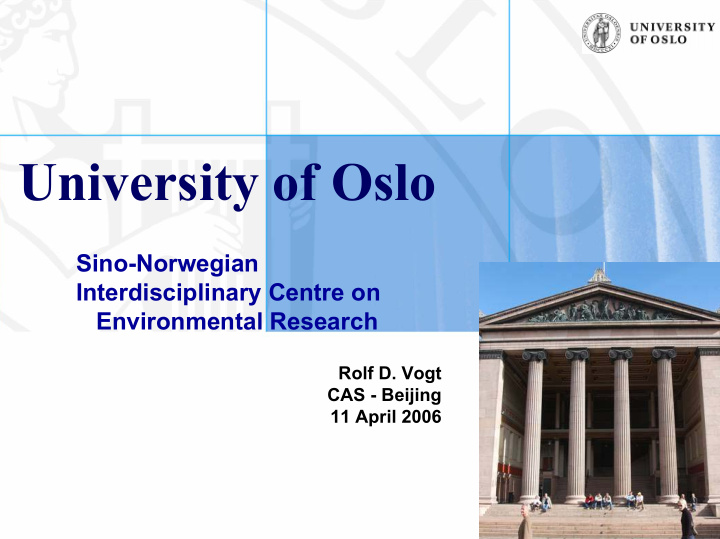



University of Oslo Sino-Norwegian Interdisciplinary Centre on Environmental Research Rolf D. Vogt CAS - Beijing 11 April 2006
Norway’s Leading University • Located in the capital • Oldest university in Norway (1811) • Largest research and teaching institution in the country • 8 Faculties –Over 70 academic units: • 44 departments • 16 Interdisciplinary research centres and 3 centres of excellence (CoE) • 2 museums –30 000 students –5400 employees of which • 3000 are academic staff – 20 % are externally financed. – Student/academic staff ratio of 10 • Rated 20th best in Europe, 69th in the World (Shanghai Jiaotong Rating 2005)
Number of Staff per Faculty Dentistry Law Education UKM UNM Centres Social Sciences Theol. Science Humanities Medicine
Faculty of Mathematics and Natural Sciences • 4000 students 9 Departments: • Multi/interdiciplinary science Department of Theoretical Astrophysics Department of Molecular Biosciences – Atmosphere, hydrosphere, Department of Biology pedosphere/geosphere, and biosphere School of Pharmacy • Local, regional and global scale Department of Physics Department of Geosciences • 2 Nobel prizes Department of Informatics – Odd Hassel in chemistry (1969) and Department of Chemistry Ivar Giæver in physics (1973) Department of Mathematics “Water and the environment”
University Centres Centres under the UiO Board National Centres • The Biotechnology Centre of Oslo • The Norwegian Centre for Human Rights • Centre for Womens’ Studies and • The Centre for Studies of Holocaust and Religious Gender Research Minorities • Centre for Development and Nordic Centres the Environment • Nordic Institute for Women’s and Gender Research • Nordic Institute for Maritime Law Science faculty centres • National –Centres of Excellence • Molecular Biology and Neuroscience • Mathematics for Applications • Physics of Geological Processes –Other • Norwegian Centre for Science Education • Centre for Entrepreneurship • Centre for Accelerator based Research and Energy Physics • Centre for Materials Science and Nanotechnology • Nordic –Centres of Excellence • Centre for Ecological and Evolutionary Synthesis –Other • Research in Water Imbalance Related Disorders • International –Centre for Geohazards
UiO - CIENS • From October 2006 • Co-operation between autonomous research Institutes and the UiO. – Linking applied and basic research • CIENS can act as a legal entity, a foundation in collaborations and coordinated projects • Proximity – on campus! • UiO member of all common research themes • Described in more detail by Dr. Naustdalslid
International Cooperation General Principles • Strength through collaboration • Equal Partnerships • Long Term Institutional Cooperation • Global Solidarity • Excellence as goal • Holistic approach
Areas of ongoing research btw UiO and Chinese institutions, examples: Natural Sciences Environmental Chemistry; Geosciences; Biology; Physics; Astrophysics; Materials & Nanotechnology; Molecular Biology & Neuroscience; Pharmacy Social Sciences: Environmental Economics; Environmental Politics ; Economics; Sociology; Anthropology Humanities: Chinese Philology & Literature; Ibsen Studies; World Religions; Minority Studies; Anthropology & Cultural studies; Ethnicity; Tibetan studies; Women & Gender studies Law: Human Rights; Minority Studies; Maritime Law Medicine: Several aspects within Basic & Clinical Research (incl. Cancer Research); Medical Rehabilitation
Formal Cooperation agreements with Chinese institutions • General: Peking University, Fudan University, Nanjing University, Wuhan University, Chinese Academy of Social Science • Network: Nordic Centre in Fudan (www.nordiccentre.org/) Tibet-Norway • Incl. Bilateral agreements with Tibet University and Tibetan Academy of Social Sciences Nanjing University & Zhejiang University (WUN) • Faculty or Departmental: Taiyuan University of Sci. and Tech. (Dept. of Chemistry) Zhengzhou University,1st Clinical Med. College (Medicine )
Forthcoming agreement with CAS Sino-Norwegian Interdisciplinary Centre on Environmental Research (NICER) • Bilateral agreement between CAS and UiO, based on Proposed during the meeting between CAS and common research interests UiO, lead by their university president, in Beijing, September 2005. with Faculty of Science, UiO –Initiation funded through CAS and the BILAT program of the Research council of Norway –Proposed run by CAS & CIENS
NICER Vision : To act as a catalyst, coordinator and mediator for research cooperation between China and Norway within the field of environmental science - Facilitate interdisciplinary and policy relevant research and serve as a node for a broad network of associated institutions
Purpose For the Chinese partners: • Constitute a formalised forum for cooperation – with Norwegian environmental researchers, with potential to increase access to international research funding For the Norwegian partners: • Provide updated information on current environmental issues – regarding: • policy initiatives • ongoing activities in the Chinese research communities • potential cooperation possibilities Further development of well established – interdisciplinary research networks • Policy relevant research – Arrange workshops to convey research findings to policy advisors and policy makers
Participants (to be completed) NICER CAS CIENS NORAD/ CAS SEPA MoE NSFC CIENS UD/MD? Research council? RCEES PKU Wuhan UiO NIVA NILU ECON GYIG Tsinghua Nanjing Geo Other? Renmin Chemistry Biology CICERO
Impetus What does China seek - that Norwegians are especially good at? � Harmonious and sustainable growth � Integrated environmental research on side effects of economic growth – > 30 years of lessons learned – successful results � Holistic approach – Multieffect studies Exceedence of – Modelling Acid Rain – From science to policy (meq/m 2 /yr) (effect based emission reduction strategy) � Last 16 years also in China – Opportunity of doing it right the first time around
Themes – Holistic perspective � Air pollution and its impacts - Emission, transport and deposition of pollutants - Impact on natural and managed eco-systems - Human health effects � Cost-benefit analysis � Science to Policy - Synergies and trade-offs - DPSIR - Local and regional air pollution, and - Sustainable resource management climate change mitigation - Economic cost and welfare losses - Linkages between economic and social - Policy instruments development and environment � Environmental change � Water quality - Landscape ecology and biodiversity - Cause - effect - Climate change - Surface water - Issues of vulnerability and - Soil water and ground water adaptative capacity - Irrigation and drinking water
! 欢迎指导 ! 欢迎指导 Thank You 谢 Thank You 谢 谢 谢 ! !
Recommend
More recommend